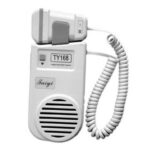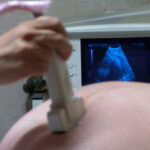Doctors have a wide variety of devices available that are used to test just about every part of the body. A carotid doppler ultrasound is one of those many devices. This is a test where a doctor is able to look at the main arteries that feed blood to your brain. You have a left and right carotid artery. Together, these two arteries are responsible for supplying almost all of the blood that your brain needs. There are times when it is necessary to look at the functioning of these arteries, and a carotid doppler ultrasound is an excellent method.
The carotid arteries can actually be felt in your neck as they rise up from your chest. Place your finger on your neck, just to the side of your Adam’s apple and you can feel the pulse. The carotid arteries split in the upper part of the next in to the internal and external carotids. Both of these can be visualized using a carotid doppler ultrasound.
There are many reason to do a carotid doppler ultrasound. If a person is having any symptoms that make a doctor suspicious that the brain isn’t getting enough blood, one of these tests can be done. An example would be unexplained fainting in an elderly person with high cholesterol. There are many other conditions as well.
The carotid doppler ultrasound is a device that uses very high frequency sound waves. It bounces those waves off the structures in your neck, and uses a computer to form an image. The sound waves are not able to be heard by your ears. The images that are created can tell a doctor a lot about the structure of the arteries, as well as the flow of blood through those arteries.
The carotid doppler ultrasound has many advantages compared to other methods of looking at the same structures. It’s cheap and quick to do. The soundwaves are harmless and involve no radiation as with CT scan and x-rays. You don’t have to stuff the patient in to a small MRI or CT scanning machine, which can cause severe claustrophobia. There is no need for contrast dyes or injections of any sort. The test can be done very quickly, and often at bedside if a patient is immobile.
Let’s look at some of the specific parameters that can be examined with the use of a carotid doppler ultrasound. It’s possible to measure the direction and velocity of blood flow through the arteries. This can tell you if there are blockages. It’s possible to measure the diameter of the inside of the vessels (known as the lumen). The thickness of the arterial wall can be measured.
It’s also possible to see if there are any calcium or cholesterol plaque deposits building up on the walls of the arteries. These can block the proper flow of blood, or they can break off and stick somewhere in the brain, causing a stroke.
A carotid doppler ultrasound is typically performed by a radiology technician who has been specially trained to do this type of test. The results are somewhat dependent on the skill of the technician. A complete exam of both carotid arteries usually takes about 20 minutes from start to finish and is completely painless.
If you have questions about a carotid doppler ultrasound, have a talk with your doctor.
Source: medical school and experience as a practicing doctor.



